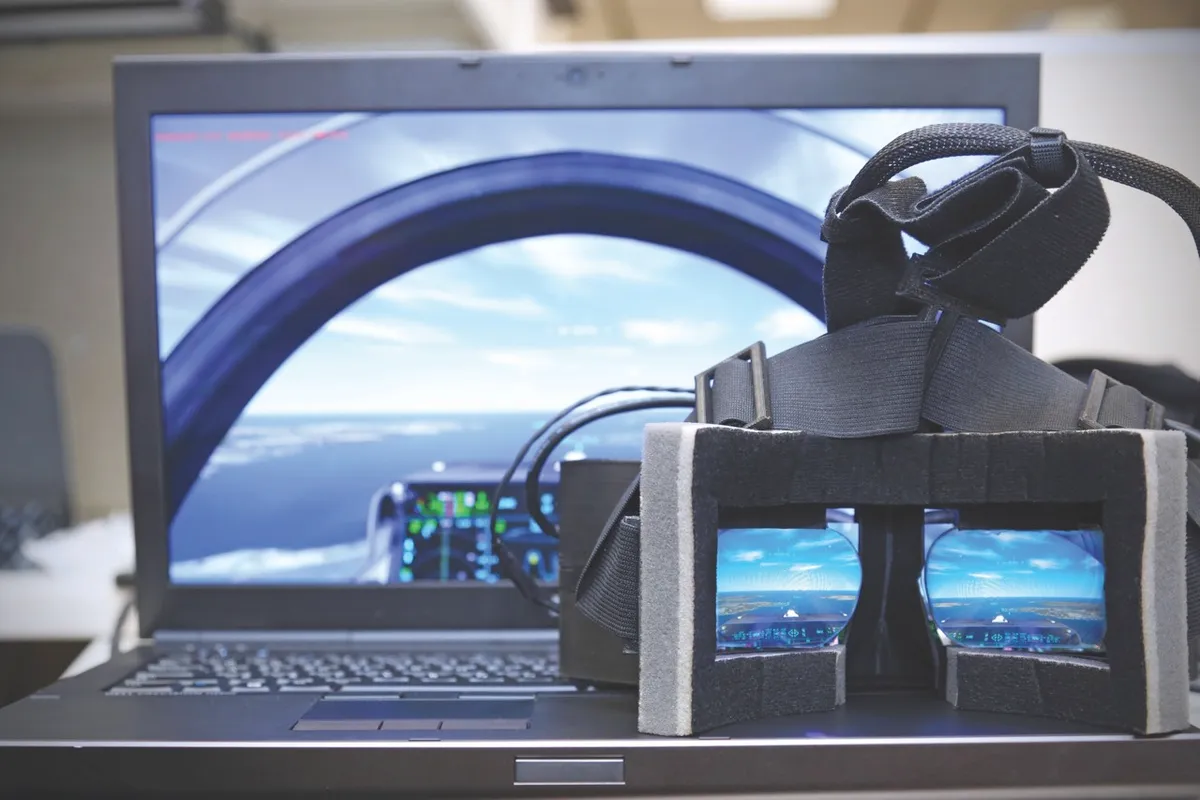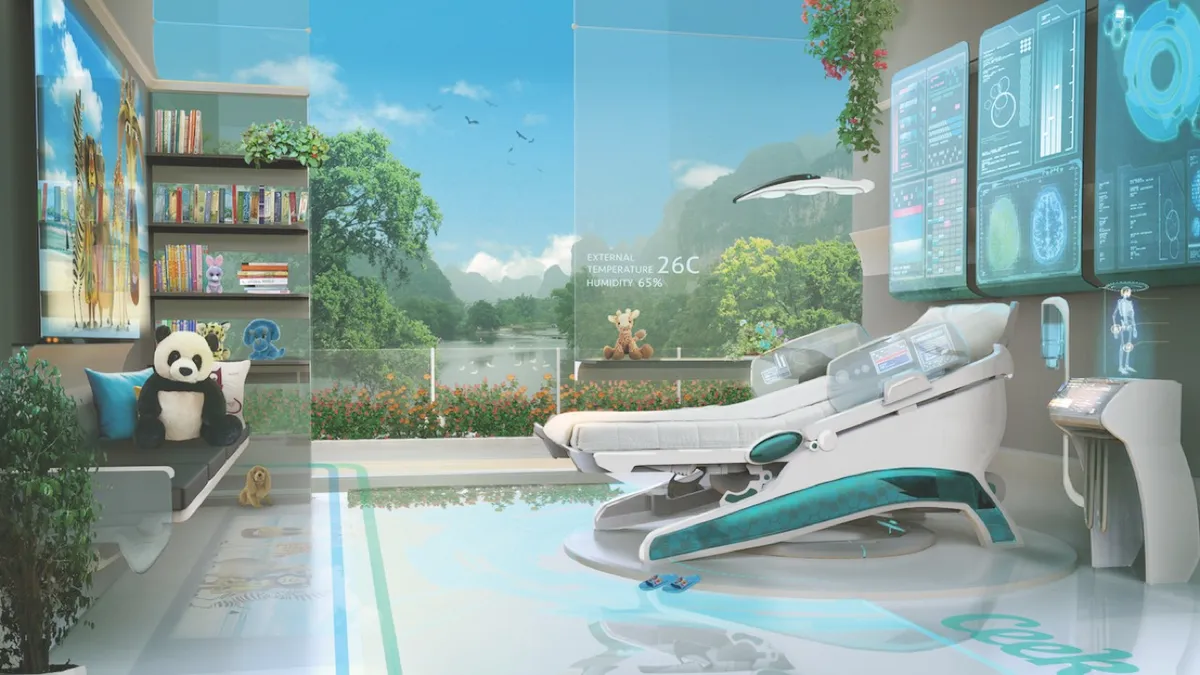BUSINESS TO BUSINESS (B2B)
How do you sell an aeroplane? When the main product you sell can reach hundreds of thousands of kilos in weight, it is not something you can simply cart around, and when your client wants to make bespoke adjustments or see how features work in the real world, demonstrations can be a logistical nightmare.
Traditionally, companies like Airbus would rely on large events like theFarnborough International Airshowto show off the capabilities of their planes, or use flight simulators that are bulky and unrealistic. But this year, the European aircraft manufactures turned to the virtual world to immerse prospective clients on the flight deck of an A350, or deliver medical aid from a rescue helicopter in a disaster area.
Swindon-based CGI specialistsRendermediawere charged with creating the series of bespoke virtual reality experiences for Airbus. “VR brings context to clients’ business, and it brings scale,” says Mark Miles, Creative Director at Rendermedia. “Airbus can’t show you what it is like being in the cockpit of a A400M with a scale model or on the computer desktop in 2D. With virtual reality you are there right in the centre, bringing their products to life.”
“It’s not enough these days to just sayhere’s the product, you need to show it in a realistic scenario. The benefit of VR is that it creates emotional triggers, meaning people remember it more and have a deeper recognition of the brand.”
The reward for companies using virtual reality to sell their products can huge, Airbus alone managed to secureover $35bnof orders following Farnborough this year.
“Context is so crucial when you’re trying to build a business case,” says Miles, “and for companies VR is the difference between being told a story, and actually beinginthe story.”
REAL ESTATE

Of the many stresses you encounter on the joyous journey of buying a house, the time and costs involved when viewing properties are among the biggest inconveniences. And those inconveniences are multiplied if you’re looking for a home in another country.
Photos, 360° videos and Skype viewing give potential buyers a taste of the properties they’re considering but they don’t solve the problem completely. To enjoy a more rounded appreciation of the house and its interior space, you need to get inside it, which again requires travel and expense. Unless, that is, you can wander around the prospective properties remotely, which is precisely whatvirtual realityallows you to do.
In July 2015 UK estate agents Savills unveiledHoroma, a system that let interested parties take a self-guided tour of the £16.75-million mansion Furze Croft in Surrey.
Horoma, created by the virtual-reality production companyRewind, utilises laser scanning to build a virtual reproduction of a house’s interior and head-mounted displays to let customers wander around inside. Currently it’s only a demo to showcase the technology, but Savills hopes Horoma will become a valuable tool in the marketing of properties.
Similar technology is already being used in Los Angeles, California, where the Michael Hood Real Estate Group is providing VR tours of its high-end properties in Beverly Hills and Malibu.
ARCHITECTURE

The problem at the heart of architecture is scale. Designing a building at full size is clearly not practical, so architects make their plans using scaled-down drawings and models. That helps but communicating a 3D design on a 2D format – in other words, a sheet of paper or a computer screen – doesn’t give you a true appreciation of the space within a structure. VR provides a solution by allowing architects to render their designs in 3D and at full-scale within a virtual environment.
Companies such asIrisVRin the US are developing software that enables architects to drag and drop designs into a VR programme before donning an Oculus Rift or HTC Vive headset to walk around within their building.
VR modelling also enables architects to see how much space is needed for people to use the interior effectively. As such, when British-firm 3d Architects submitted itsupdated shop-floor proposalto the Boots pharmacy chain, it included a virtual-reality shop furnished with the new design to see how customer navigation might be affected.
EDUCATION

Archaeology students at Harvard may not be able to travel back in time but, thanks to VR, they can roam around Egypt’s Giza plateau and see how it would have looked around 2500BC. Using photos, maps, notes and the excavation diaries of the Egyptologist George Reisner, an approximation of the entire site has been rendered in a virtual-reality landscape.
Life-size models of the pyramids of Khufu, Khafre and Menkaure, along with the Great Sphinx and other structures in the necropolis, have been created by Dassault Systèmes as part of a joint venture with Harvard University and the Museum of Fine Arts, Boston. The virtual model is the only place where every temple and tomb structure on the Giza plateau can be seen reconstructed together.
How does it work? Inside theVisualization Centerin Harvard University’s Earth and Planetary Sciences Department, students don 3D glasses and sit in front of a 23-foot semi-circular screen onto which the Giza reconstruction is projected. The students can then decide where to go and which element they’d like to examine in detail, including the subterranean shafts and burial chambers.
AUTOMOTIVE INDUSTRY

A challenge for car manufacturers is marrying the design aesthetic with the practicalities of fuel efficiency and aerodynamics while making the end result appealing to the consumer. It can be a long, laboured and costly process but one that’s becoming more streamlined thanks to VR.
At Ford’s headquarters in Michigan, the American car behemoth has use of an ultra-high-definition VR facility that allows its designers and engineers to sit inside life-size virtual versions of prototype vehicles. As well as showing them a full-scale, 3D model of the proposed car, the Ford Immersion Lab also lets engineerssee beneath the bodyworkto examine how its mechanical systems work.
In 2013 alone, the Immersion Lab was used to check 135,000 details on 193 prototypes, and resulted in changes to the wing mirrors on the Ford Fusion (Mondeo) and windscreen wipers on the new Mustang. Ford’s certainly confident in the technology after being one of the early adopters all the way back in 2000, where they employed it to refine the bodies and cabins of its range of cars.
And it’s not just the designers who are benefiting. At CES 2016, Audi announcedvirtual showroomswill soon become the norm. Working with Nvidia Quadro GPUs and VR suppliers Oculus and HTC, Audi is introducing the new concept to allow customers to experience Audi vehicles there and then, even if the specific model isn’t stocked by the dealership. Audi expect the first showroom to go live in the US later this year.
TOURISM

Nobody is seriously suggesting that VR could be an alternative to actually going on holiday but it has a role to play in marketing trips overseas. In 2014 British travel agency Thomas Cook teamed up with VR production companyVisualiseto produce immersive experiences of the holidays they offer.
Customers visiting the Thomas Cook branch in the Bluewater shopping centre could slip on a Samsung Gear VR headset and be instantly transported to one of the many locations the company arranges travel to. Achieving this required the Visualise staff flying to Egypt, America and the Far East over a period of months, andshooting 360° footageof the attractions and activities holidaymakers could experience in those places.
Without leaving the shop in Kent, customers could stroll among the Pyramids, scuba dive in Sharm-el-Sheikh, take a helicopter tour of Manhattan or walk across the OCBC Skyway suspended 22m above Singapore’s Marina Bay. When it comes to choosing a potential holiday destination, it certainly beats flicking through travel brochures. Thomas Cook seems to think so, at least, as the VR system is said to have led to flights and hotel bookings totalling £12,000 in the UK in the three months after its official launch in 2015.
FLIGHT SIMULATION

Flight simulators first appeared in 1976. The VR environment inA2FS1 Flight Simulatorwas limited but, in the 40 years since, VR flight simulators have become a sophisticated and crucial training tool.
“It’s all about bringing affordability and safety to pilot training,” explains Atul Patel, director of advanced technologies at Lockheed Martin, a manufacturer of military simulators. “From the military perspective, a lot of aircraft are single-seaters and training a pilot to fly one of those is more difficult [as the instructor can’t accompany the trainee]. That’s where simulators come in.
“We ensure the virtual aircraft’s dynamics are modelled accurately so the pilot can understand exactly what’s going to happen when he’s flying the real plane,” adds Patel. As the pilot’s skill increases, the simulators allow the instructors to introduce new challenges to keep the trainee progressing.
“If you’re training a pilot to land on a aircraft carrier, we can induce crosswinds on the final approach, which is a very dangerous situation in reality but a pilot has to learn to handle it,” Patel says. “As they improve, we can make the carrier deck pitch and roll, which frankly you wouldn’t want a trainee to encounter in real life, but in a simulator he can learn to deal with that situation safely.”
VR flight simulators aren’t just the preserve of pilots with engineers and mechanics benefiting, too. “Think about the complexity of the aircraft and their engines,” says Patel. “Having a virtual capability to learn how to access and work on them is critical. And a virtual environment is a more affordable and quicker way to train the mechanics than having to put them to work on a real aircraft.”
MEDICAL TRAINING

Dentistry is one of the leading pioneers in the application of VR technology. Take student dentists at King’s College London who’ve been using theHapTEL Virtual Dental Lab– essentially a virtual-reality mouth – to develop their drilling skills since 2010.
Instead of peering down into a patient’s mouth, the undergraduates sit over a monitor that displays a 3D representation of either a specific tooth or a complete jaw. By wearing special glasses that track their head movements, the students are able to examine the tooth or jaw from various angles.
They work on the tooth using a replica drill that provides haptic feedback to give them the sensation of drilling into a real tooth. The feedback is sensitive enough to help the trainees differentiate between drilling into healthy or decayed enamel – a skill that’s crucial to prevent them from applying too much pressure and damaging the patient’s teeth, gums or jaw.
Aside from eliminating the risk of injuring real patients while the new dentists train, a key advantage of the HapTEL Virtual Dental Lab is cost. One HapTEL unit costs £10,000 but prices for the mannequin heads filled with plastic teeth – the previous training method – reach up to £40,000. Also, the plastic teeth could only be drilled once and cost £16 each to replace.
Other branches of medicine are also starting to appreciate the potential benefits of VR training. In 2015, the Miami Children’s Hospital began collaborating with Next Galaxy, a VR content developer, to build VR software that trains people to perform life-saving emergency procedures, such as cardiopulmonary resuscitation or clearing blockages from a choking person’s throat.
Follow Science Focus onTwitter,Facebook, Instagramand Flipboard